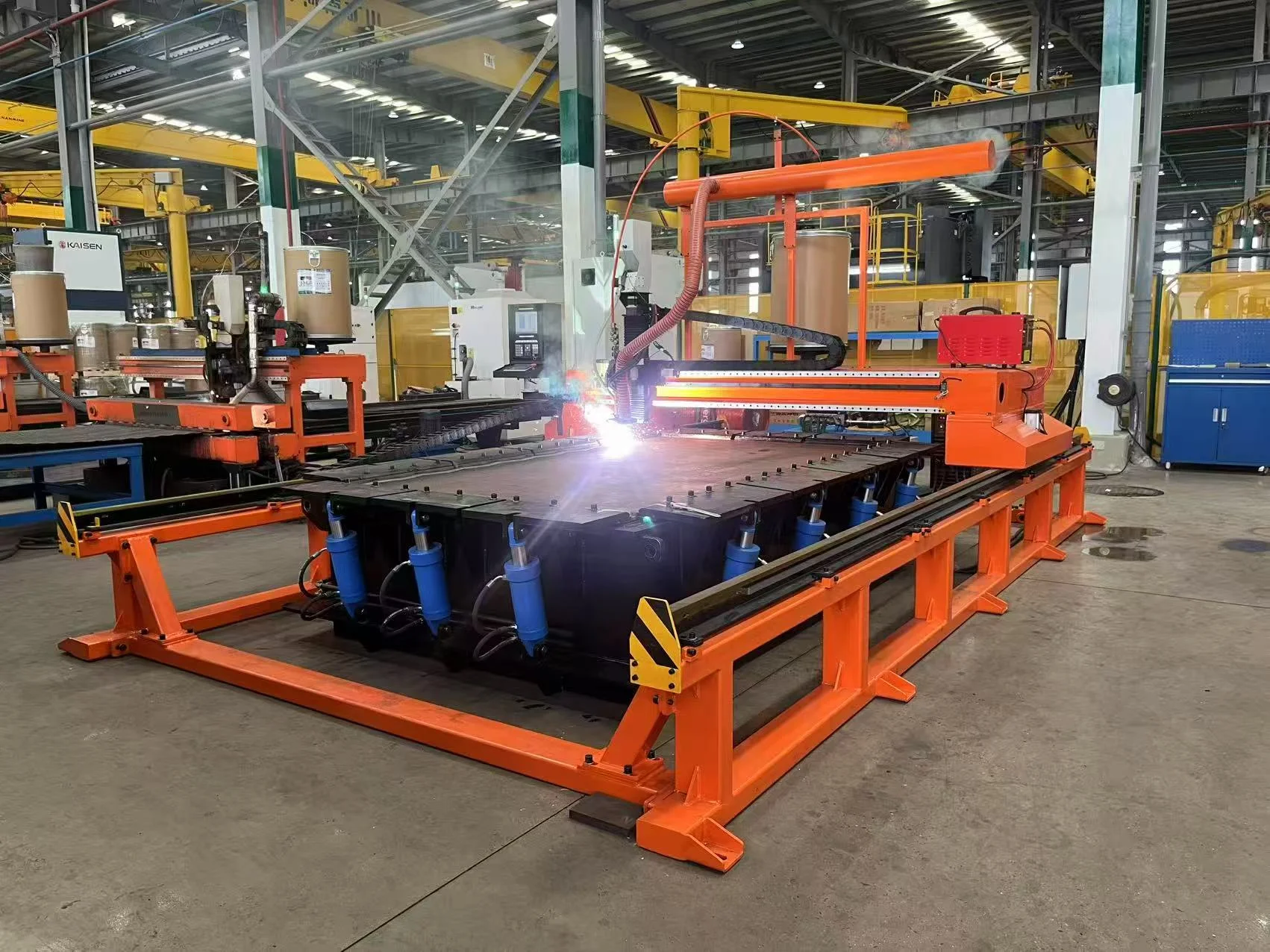- This topic is empty.
-
AuthorPosts
-
2025-10-27 at 2:48 pm #4980
In industrial manufacturing, mining equipment, and metallurgical machinery, wear-resistant plates play a critical role in prolonging equipment life and improving operational efficiency. Hardfacing technology is essential for the production and repair of these plates. With advancements in industrial automation, hardfacing equipment has become increasingly diverse. Among the most common types are single-torch and multi-torch wear plate hardfacing machines. This article provides an in-depth comparison of these two machines in terms of working principle, efficiency, cost, maintenance, and application scenarios, helping companies make informed decisions.
1. Overview of Single-Torch Wear Plate Hardfacing Machines
A single-torch hardfacing machine operates with only one welding torch during the process. Its main characteristics include simple operation, lower cost, and easier maintenance. Single-torch machines are often equipped with precise welding control systems to ensure stable weld quality and high accuracy.
Working Principle
The typical workflow of a single-torch hardfacing machine is as follows:
-
Secure the wear plate on the worktable.
-
Control the welding torch, either manually or via a robot, to perform point-by-point hardfacing.
-
Melt the filler material through the torch to fuse with the base metal, forming a wear-resistant layer.
-
Repeat the process to build up the desired thickness.
Since only one torch is involved, the welding path is relatively simple, and the system can precisely control the welding parameters.
Advantages
-
Low equipment cost: Ideal for small to medium-sized enterprises due to lower initial investment.
-
Flexible operation: Can handle various plate sizes without complex synchronization systems.
-
Simple maintenance: With only one torch, the system has fewer points of failure, reducing repair costs.
-
High weld precision: Controlling one weld seam at a time allows for precise thickness and quality control.
Disadvantages
-
Lower efficiency: One torch covers only a single seam at a time, making large-area welding time-consuming.
-
Labor-intensive: Manual or semi-automatic operation requires constant monitoring.
-
Limited for large-scale production: Low output may become a bottleneck for high-demand operations.
2. Overview of Multi-Torch Wear Plate Hardfacing Machines
Multi-torch hardfacing machines use two or more welding torches simultaneously. Modern multi-torch systems are typically fully automated and can synchronize multiple welding points, significantly improving production efficiency.
Working Principle
Multi-torch machines operate as follows:
-
Secure the wear plate on a multi-axis worktable.
-
Multiple welding torches work simultaneously along preset paths.
-
Filler material melts at multiple points, forming a uniform wear-resistant layer.
-
The system automatically moves to the next welding area as needed.
Modern multi-torch machines utilize precise synchronization control to ensure even weld thickness and consistent quality.

Advantages
-
High production efficiency: Simultaneous multi-point welding can reduce production time by 30%-70%, ideal for large-scale production.
-
Suitable for large-area welding: Especially effective for mining machinery, steel plants, and other applications requiring extensive coverage.
-
High automation level: Typically equipped with PLC or robotic systems, minimizing manual intervention.
-
Uniform welds: Precise control ensures consistent hardness and thickness across the entire plate.
Disadvantages
-
High investment: Complex structure and automation require significant initial capital.
-
High maintenance cost: Multiple torches increase the complexity of troubleshooting and repairs.
-
Technical skill requirement: Operators need experience with automated systems to maintain optimal performance.
3. Detailed Comparison: Single-Torch vs. Multi-Torch
Aspect Single-Torch Machine Multi-Torch Machine Initial Investment Low High Production Efficiency Medium-Low High Weld Precision High Medium-High (requires calibration) Applicable Plate Size Small to Medium Medium to Large Operation Complexity Simple High Maintenance Cost Low High Ideal Enterprise Scale Small to Medium Large or High-Volume From the table, it is evident that single-torch machines suit enterprises requiring high weld precision with moderate production, while multi-torch machines excel in high-volume, fast-paced production environments.
4. Selection Guidelines
Choosing between single-torch and multi-torch hardfacing machines depends on practical requirements:
-
Production Volume
-
For daily output below 500 m², single-torch machines are sufficient.
-
For outputs exceeding 500 m²/day, multi-torch machines offer significant time savings.
-
Weld Precision
-
High-precision weld seams favor single-torch machines.
-
For large-area wear plates, multi-torch machines achieve uniform welding within acceptable tolerances.
-
Budget and Enterprise Scale
-
Small to medium enterprises with limited budgets may prefer single-torch machines.
-
Large enterprises prioritizing efficiency and automation should invest in multi-torch systems.
-
Maintenance and Technical Capability
-
If skilled automation technicians are unavailable, single-torch machines are easier to operate.
-
Enterprises with trained staff can leverage multi-torch systems for maximum productivity.
5. Future Trends
As Industry 4.0 advances, wear plate hardfacing technology continues to evolve:
-
Intelligent Control: AI algorithms enable automatic weld quality detection and adaptive parameter adjustment in multi-torch machines.
-
Flexible Production: Modular torch units allow switching between single-torch and multi-torch modes to balance precision and efficiency.
-
Eco-Friendly Welding: New filler materials and processes reduce energy consumption, improve efficiency, and minimize welding fume emissions.
These trends suggest that the distinction between single-torch and multi-torch machines may blur, offering companies more flexible and efficient solutions for wear plate production.
6. Conclusion
Single-torch and multi-torch wear plate hardfacing machines each have their advantages and limitations. Single-torch machines offer lower investment, simpler operation, and high weld precision, but efficiency is limited. Multi-torch machines provide high production efficiency and suitability for large-scale operations, but require higher investment and maintenance.
In summary, single-torch machines are suitable for small to medium enterprises with moderate production and high precision requirements, while multi-torch machines cater to large-scale, high-volume production. With increasing automation and flexible manufacturing solutions, the combination of single- and multi-torch hardfacing technologies will likely become a future trend, providing versatile solutions for wear plate applications.
http://www.jhnm-hardfacing.com
jhnm-hardfacing -
-
AuthorPosts
- You must be logged in to reply to this topic.
